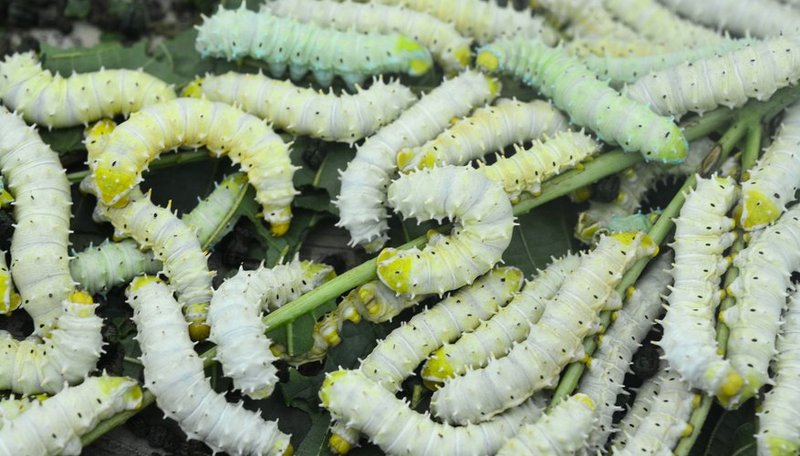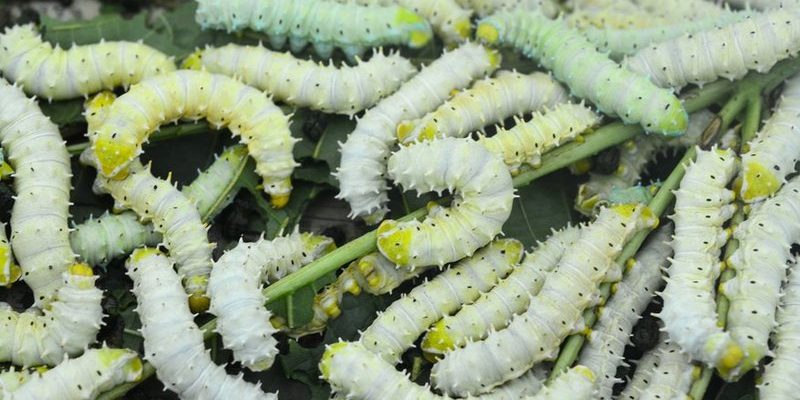
Have you ever thought about how silk gets from a caterpillar to the luxurious fabric draped on a runway? Meet the silkworm—a creature whose life cycle and habits are as fascinating as the fabric it produces. Silkworms are the larvae of the silk moth, and they play a crucial role in the production of silk that has been cherished for thousands of years.
When you picture a silkworm, imagine a tiny, soft creature munching on mulberry leaves, gradually transforming into a cocoon. This magical transformation happens through a process that captivates scientists and fashionistas alike. If you’ve ever been curious about how such a humble caterpillar can produce something so luxurious, you’ve come to the right spot. Let’s unravel the life and significance of silkworms together!
What are Silkworms?
Silkworms, or *Bombyx mori*, are the domesticated larvae of the silk moth. These caterpillars have a fascinating story to tell. Originally from China, they’ve been raised for silk production for over 5,000 years. The silkworm is part of the Bombycidae family. It’s remarkable how these little critters have woven themselves into the fabric of human history!
During their short but eventful lives, silkworms go through several stages, known as instars. They start as tiny eggs, then become caterpillars, and finally transform into moths. Each stage has its own unique characteristics, but what sets silkworms apart is their ability to spin silk. The silk thread they produce is incredibly strong and can be spun into beautiful garments.
Interestingly, silkworms can only feed on specific plants—primarily the leaves of the mulberry tree. These caterpillars are picky eaters, and their diet plays a vital role in the quality of the silk they produce. The journey from egg to moth involves not just changes in size but also spectacular changes in color and texture.
The Life Cycle of a Silkworm
The life cycle of a silkworm is an incredible process that unfolds in several stages. It begins when silkworm eggs hatch into larvae, which are commonly known as caterpillars. This hatching is like the beginning of a grand adventure. Once hatched, these little ones are voracious eaters, spending most of their time munching on mulberry leaves, growing rapidly.
After several days of feasting, they enter the larval stage, shedding their skin multiple times—a process called molting. Each molt allows them to grow larger, preparing for their final transformation. This stage is characterized by a vibrant green or yellow hue, reflecting their healthy diet and rapid growth.
Once they’ve reached their maximum size, silkworms will spin a protective cocoon around themselves. This cocoon is made of silk strands they produce, and it serves as a safe haven for their transformation into moths. It’s like a cozy blanket that they wrap themselves in, leading to their dramatic metamorphosis. Inside this cocoon, they undergo a complete transformation, turning into beautiful moths ready to emerge into the world.
Silkworm Habitat and Behavior
Silkworms thrive in controlled environments where conditions can be tailored for their optimal growth. They are typically raised in sericulture, where farmers can ensure they have the right temperature, humidity, and plenty of food. This is crucial because these creatures are quite sensitive to their surroundings. In the wild, you might find them in mulberry plantations, but most silk production happens in specially designed spaces to maximize yield.
The ideal habitat for silkworms is warm and humid, mimicking the conditions of their native environment. They require a temperature range of around 70-85°F (21-29°C) and humidity levels between 60-80%. This careful balancing act is essential for their survival and productivity.
Behaviorally, silkworms are fascinating. They are mostly nocturnal, coming alive during the night to feed. They’ll eat nearly constantly, which is why they gain weight so quickly. Interestingly, they produce different types of silk based on their diet and the conditions they are kept in. This silk varies in texture and strength, which can influence the quality of the final silk product.
Interesting Facts about Silkworms
| Scientific Name: | Bombyx mori |
| Average Size: | 2-3 inches (5-7.5 cm) in length |
| Diet: | Primarily mulberry leaves |
| Lifespan: | Approximately 6-8 weeks |
| Cocoon Composition: | Silk proteins (fibroin and sericin) |
| Mating Season: | Spring and summer |
The Importance of Silkworms in Human Culture
Silkworms have not only shaped the textile industry but also left a significant mark on cultures around the world. Since ancient times, silk has been a symbol of luxury and wealth. This precious fabric was so valuable that it was often used as currency. Imagine trading a few yards of silk for a horse or a piece of land! The significance of these little caterpillars extends beyond their economic value; they have also inspired art, fashion, and traditions.
In many cultures, silk is linked with purity and beauty. For instance, in China, silk was historically reserved for emperors and those of high status. Their association with elegance and refinement continues to this day. Traditional celebrations often feature silk garments, reflecting the fabric’s enduring allure.
Moreover, the craft of sericulture (silk farming) has led to profound social impacts. It creates jobs and fosters communities, especially in rural areas where mulberry trees are cultivated. The entire process, from raising silkworms to spinning silk, involves a unique set of skills passed down through generations. That’s why silkworms are not just insects—they represent an ancient tradition and a vibrant cultural legacy.
Challenges and Conservation of Silkworms
While you might think that raising silkworms is straightforward, the reality is that sericulture faces several challenges. One of the most significant issues is competition from synthetic fabrics. As more people turn to cheaper, man-made materials, the demand for natural silk has fluctuated. This can lead to difficulties for silk farmers who rely solely on silkworm production.
Climate change also impacts silkworm habitats. Changes in weather patterns can affect the growth of mulberry trees, which are essential to their diet. If these trees struggle, so will the silkworms. Farmers must adapt to these changes by employing sustainable practices to ensure the health of both their crops and the silkworms.
Conservation efforts are underway to support both natural habitats and the tradition of sericulture. Research is being conducted to develop silkworms that can thrive in varied environments while maintaining the quality of silk. By fostering sustainable practices, we can help ensure that silkworms continue to play a vital role in our culture and economy.
How to Raise Silkworms at Home
If you’re intrigued by the idea of raising silkworms, it can be a rewarding and educational experience! Here’s a simple step-by-step guide to get you started:
- Get your supplies: You’ll need silkworm eggs, a container for raising them, and plenty of mulberry leaves. Make sure the container has good ventilation!
- Hatch the eggs: Place the eggs in a warm area. They usually hatch in about 10 days. Exciting, right?
- Feed regularly: Once they hatch, provide fresh mulberry leaves daily. Watch them grow and enjoy their journey!
- Prepare for spinning: Once they reach full size, provide a suitable environment for them to spin cocoons. This usually involves transferring them to a container with soft bedding.
Raising silkworms can teach valuable lessons about life cycles, biology, and even responsibility! Plus, it’s a hands-on way to understand the process behind silk production.
FAQ
What do silkworms eat?
Silkworms primarily feed on the leaves of the mulberry tree. They are quite particular about their diet, and this specific food is essential for their growth and the quality of the silk they produce. Providing fresh, chemical-free mulberry leaves is vital to their health.
How long does it take for a silkworm to become a moth?
The entire life cycle of a silkworm, from egg to moth, typically takes about 6 to 8 weeks. After hatching, they spend around 4 to 6 weeks as larvae, during which they molt several times before spinning their cocoons. The metamorphosis inside the cocoon takes about 10 days, after which they emerge as moths.
Can silkworms survive in the wild?
While silkworms can survive in the wild, they are predominantly domesticated due to their specific dietary needs and breeding practices. In the wild, they face challenges such as predation and fluctuating temperatures, which can make survival difficult. Most silkworms today are raised in controlled environments to ensure they thrive.
Is it ethical to raise silkworms for silk?
This question often sparks debate. Some argue that raising silkworms for silk is ethical when done humanely, as it provides livelihoods for many farmers. Others point to the killing of the silkworms during the cocooning process as a concern. It’s essential for consumers to be aware of how silk is produced and to support sustainable practices.
Can I find silkworms in my garden?
Silkworms are not typically found in gardens since they have specific habitat requirements. They need mulberry trees to survive, and unless you have these trees readily available, you won’t likely encounter silkworms outside of a controlled setting or a sericulture farm.
What is the significance of silk in different cultures?
Silk has played a vital role in various cultures, often symbolizing luxury and refinement. In China, it was historically used for currency and reserved for the elite. Many cultures use silk in traditional garments and celebrations, highlighting its beauty and cultural importance.
How can I start my own silk business?
If you’re interested in starting a silk business, it’s crucial to research and understand the process of sericulture. This includes raising silkworms, harvesting silk, and learning about market demand. Building connections with silk suppliers and potential customers can also help ensure your success in this industry.
What threats do silkworms face today?
Silkworms face various threats, primarily due to climate change and competition from synthetic fabrics. Changes in weather can impact their food supply, while cheaper alternatives can decrease demand for natural silk. Sustainable farming practices and awareness can help combat these challenges.
Are there any silk alternatives?
Yes, there are several alternatives to silk, including synthetic fabrics like polyester and natural fibers like cotton or bamboo. Each has its own set of characteristics and qualities, but nothing quite matches the unique texture and luster of real silk. Consumers often choose based on their preferences for sustainability and ethical considerations.
How do silkworms benefit the environment?
Silkworms play a role in maintaining agricultural ecosystems. By promoting mulberry tree growth, they help maintain local biodiversity. Sustainable sericulture practices can also contribute positively to the environment by supporting organic farming methods and reducing the use of harmful chemicals.
Can I eat silkworms?
Yes, in some cultures, silkworms are considered a delicacy and are consumed as a food source! Known as “silkworm larvae,” they are often cooked in various ways. They are rich in protein and are a popular choice in certain Asian cuisines, showcasing the versatility of this unique creature.

